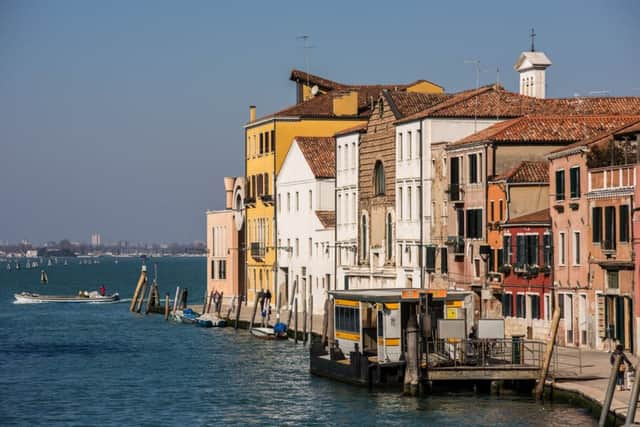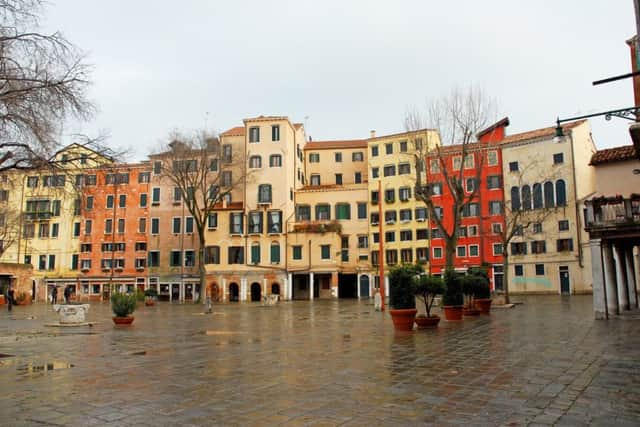Venice: Visit the Venetian ghetto


In July this year, to mark both the 400th anniversary of his creator’s death and the 500th anniversary of the foundation of the ghetto, there was Shylock striding about on those dire stones in a production of The Merchant Of Venice, demanding his pound of flesh and challenging spectators to face the enigmas associated with him and with the ghetto itself. Was he a victim or a villain? Was the establishment of the ghetto an act of oppression and discrimination, or was it a means of offering a persecuted minority some protection, and of allowing the Jewish people a place to follow their own traditions and to worship in their own rites?
The Campo del Ghetto is now an obligatory stop on the tourist trail in Venice, and is still, to some extent, a centre of Jewish life and culture, and certainly of Jewish history. The word “ghetto” is not Hebrew but one of the three Venetian dialect words, along with arsenal and lido, which are have entered the globalised language. In Venice, the word meant “foundry” and acquired its present sense when, in 1516, the Senate of the Most Serene Republic set aside a campo (square) for the exclusive residence of the Jewish population. The place chosen had previously housed a foundry, and so the two words became confused. The Venetian ghetto was the first and others were then established in Italy and elsewhere with the same name.
Advertisement
Hide AdThe essential structures of life are still there. Although it is now quite central and just off the trail from the railway station to the Rialto, the site was chosen partly because it was then remote, in the district of Cannaregio, which means “place of reeds”. It was sufficiently far away from the political and religious centre at St Mark’s Piazza, or from the commercial centre at the Rialto Bridge, not to be a nuisance. The area had the further advantage of being a self-contained island, surrounded by water on all sides, something less common in Venice than might be thought. Guards, paid for by the Jews, patrolled the perimeter by boat in the period between nightfall and the ringing of the great bell at the Arsenal at dawn. During that time, Jews were forbidden to leave the precinct.


The main point of access on land was through an alleyway, blocked off by a gate which was lowered during the hours of darkness. The gates were pulled down by Napoleon’s soldiers who burnt them on the square itself, but the holes in the wall alongside the Cannaregio canal, where the locks were inserted, can still be seen. In fact there are three adjoining ghettos, the Nuovo, the Vecchio and the Novissimo, built as the community expanded but all enclosed in the one precinct. There is today a kosher restaurant and bakery, but the campo, even if it is a place of memory, has long lost its exclusive association with Judaism. The Jewish people most prominently in evidence are American incomers of the ultra-orthodox Lubavitch sect who have chosen not to integrate with their Venetian counterparts.
The structures inside are as they were in the past, as is common in Venice, a city which has more than any other retained its appearance from earlier ages. Space was at a premium, so the only option for the community was to build upwards to a height of eight or nine storeys. There is a building displaying a notice which announces it contains the scala mata, the mad staircase, where whole families were packed together in tight corners and at crazy angles. The ghetto attracted Jews from elsewhere in Europe as they fled from persecution because the Jews in Venice were given a promise they would not be expelled. Inside, they were no better than the rest of humanity at establishing friendly relations, and there are three wells for the main national components of the community who refused to share, and five synagogues. The Spanish is the most spectacularly beautiful, although the German one is also attractive. Visits can be arranged from the main museum.
The architects included some of the great names of the Venetian tradition because Jews were barred from all professions, excepting medicine, in which Jewish practitioners enjoyed a high reputation, and money-lending, which was, of course, an early form of banking. They had also to pay heavy taxes. Once there were three pawnshops on the campo, the red, the white and the black, and all were used by Venetians when they needed a loan. There were no Christian institutions, because charging interest was forbidden. The red shop, with its bench outside under a portico, still stands, but is now a museum. They will tell you its colour is the origin of the phrase “in the red”. You can believe it if you will.
Shylock had some fun playing with what he took to be hints that interest had been justified in the Old Testament by Abraham, but for the production of the play, the windows of the red shop were used to allow his daughter, Jessica, to toss out her cases and his money when she was eloping with her lover, Lorenzo.


There was no scenery needed for the play other than the walls of the ancient buildings, the well heads, the isolated trees and the paving stones themselves, but these were sufficient to deepen the impact of the performance. When Shylock says of Antonio, “He hates our sacred nation,” the words gain immediacy and bitterness from the environment itself. In fact, five actors took on the role of Shylock to express, in the view of director Karin Coonrod and dramaturg Walter Valeri, the different aspects of his personality and function in society. Two were English-speaking, two Italian and the fifth a woman, who was also Italian. I doubt if it made much difference. They all delved into the recesses of an enigmatic character, and together tussled with the eternal question of whether the play was anti-Semitic or was a portrayal of anti-Semitism in action. As well as being timely because of the anniversaries involved, the work is more relevant than ever today for its cry against the treatment of outsiders, whether Renaissance Jews or modern refugees, many begging on nearby streets crowded with wealthy tourists.
Advertisement
Hide AdThe trial scene stretched beyond the play, since an American Supreme Court judge was invited to preside over a retrial of Shylock, at which the jury found, unsurprisingly, in his favour. Maybe the real trial should be of the ghetto itself, whether in Venice or in other countries. Like the city in which it is sited, it exists now on tourism, which is destroying it, yet there are fewer places of richer historical associations or more populated by ghosts.